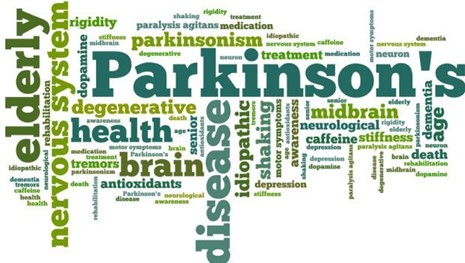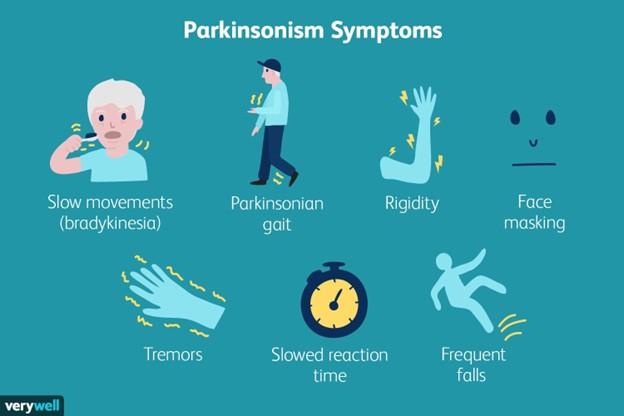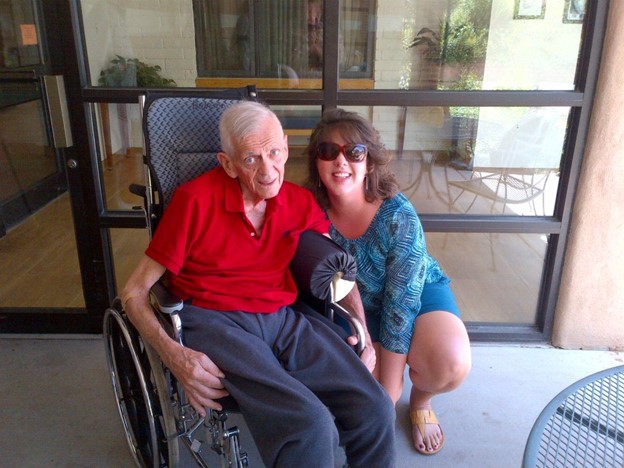Written By: Anysia Ensslen-Boggs, Ed.D., CCC-SLP
 Parkinson’s disease (PD) is a neurodegenerative disorder that affects neurons in a specific area of the brain called the substantia nigra. Symptoms generally develop slowly over several years and the progression of symptoms is often quite different from one person to another due to the diversity of the disease. Although there is no cure, treatment options can include medications, surgeries, physical, occupational, and/or speech therapy. While Parkinson’s itself is not fatal, disease complications can be serious. As rehabilitation professionals, it is important for us to understand the causes of PD, early signs of PD, movement and non-movement symptoms, and the various diagnosis and treatment options for those living with PD.
Parkinson’s disease (PD) is a neurodegenerative disorder that affects neurons in a specific area of the brain called the substantia nigra. Symptoms generally develop slowly over several years and the progression of symptoms is often quite different from one person to another due to the diversity of the disease. Although there is no cure, treatment options can include medications, surgeries, physical, occupational, and/or speech therapy. While Parkinson’s itself is not fatal, disease complications can be serious. As rehabilitation professionals, it is important for us to understand the causes of PD, early signs of PD, movement and non-movement symptoms, and the various diagnosis and treatment options for those living with PD.According to the Parkinson and Movement Disorder Society (MDS), a diagnosis of Parkinson’s is made when a person exhibits slowness of movement (bradykinesia) and one or more of the following:
- Shaking or tremor that occurs while at rest
- Stiffness and rigidity of the arms, legs, or trunk
- Trouble with balance and falls
 Early Signs of Parkinson’s disease may also include any of the following:
Early Signs of Parkinson’s disease may also include any of the following:
- Tremor
- Handwriting that is smaller than usual
- Loss of smell
- Trouble sleeping
- Trouble moving/walking
- Constipation
- Soft/low voice
- Masked appearance to face
- Dizziness or fainting
- Stooped or hunched over

This is me with my uncle, once a brilliant chemist at Los Alamos Laboratories who passed away from complications with Parkinson’s disease and accompanying Lewy Body dementia in 2013.
Many people with Parkinson’s disease report remembering non-motor symptoms appearing before motor-related symptoms. Those with PD often report these symptoms as being more disabling than motor symptoms.
- Depression
- Anxiety
- Apathy
- Hallucinations/vision changes
- Constipation
- Urinary incontinence
- Sexual dysfunction
- Digestive issues
- Sleep disorders
- Loss of smell/taste
- Variety of cognitive impairments
Due to the complexity of Parkinson’s disease and its variability from person to person, a complete care team is crucial. Those who have received a diagnosis of PD are advised to:
- Work with physician to create a plan to stay healthy – A referral to a neurologist, a doctor who specializes in the brain – Care from an occupational therapist, physical therapist, and/or speech therapist – Meeting with a medical social worker
- Start a regular exercise program to delay further symptoms – 2.5 hours of exercise a week, experience a slowed decline in quality of life compared to those who start later
- Gather support from family, friends, and PD support groups
If you’re interested in learning more about the neuroanatomy of Parkinson’s disease, young-onset Parkinson’s disease, medication, surgical interventions, and therapeutic interventions please join us on September 20, 2023, Parkinson’s Disease: Causes, Symptoms, Assessment, and Treatment.
Parkinson’s Disease: Causes, Symptoms, Assessment, and Treatment
Therapists Rehabilitation Strategies for Dementia Patients
Aphasia: What Rehab Professionals Need to Know About Diagnosis and Treatment
References:
Ball, N., Teo, W. P., Chandra, S., & Chapman, J. (2019). Parkinson’s disease and the environment. Frontiers in neurology, 10, 218.
Church, F. C. (2021). Treatment options for motor and non-motor symptoms of Parkinson’s disease. Biomolecules, 11(4), 612.
Marras, C., Canning, C. G., & Goldman, S. M. (2019). Environment, lifestyle, and Parkinson’s disease: implications for prevention in the next decade. Movement Disorders, 34(6), 801-811.
Oxtoby, N. P., Leyland, L. A., Aksman, L. M., Thomas, G. E., Bunting, E. L., Wijeratne, P. A., … & Weil, R. S. (2021). Sequence of clinical and neurodegeneration events in Parkinson’s disease progression. Brain, 144(3), 975-988.
Tolosa, E., Garrido, A., Scholz, S. W., & Poewe, W. (2021). Challenges in the diagnosis of Parkinson’s disease. The Lancet Neurology, 20(5), 385-397.
Vázquez-Vélez, G. E., & Zoghbi, H. Y. (2021). Parkinson’s disease genetics and pathophysiology. Annual Review of Neuroscience, 44, 87-108.
Vijiaratnam, N., Simuni, T., Bandmann, O., Morris, H. R., & Foltynie, T. (2021). Progress towards therapies for disease modification in Parkinson’s disease. The Lancet Neurology, 20(7), 559-572.
